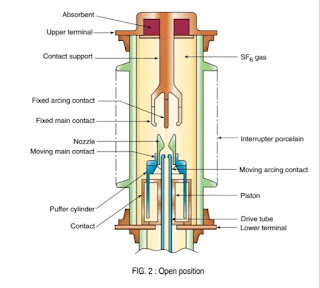A circuit breaker in which SF6 under pressure gas is used to extinguish the arc is called SF6 circuit breaker. SF6 (sulphur hexafluoride) gas has excellent dielectric, arc quenching, chemical and other physical properties which have proved its superiority over other arc quenching mediums such as oil or air. The SF6 circuit breaker is mainly divided into three types
- Non-puffer piston circuit breaker
- Single- puffer piston circuit breaker.
- Double-puffer piston circuit breaker.
The circuit breaker which used air and oil as an insulating medium, their arc extinguishing force builds up was relatively slow after the movement of contact separation. In the case of high voltage circuit breakers quick arc extinction properties are used which require less time for quick recovery, voltage builds up. SF6 circuit breakers have good properties in this regards compared to oil or air circuit breakers. So in high voltage up to 760 kV, SF6 circuit breakers is used.
Construction of SF6 Circuit Breaker:
SF6 circuit breaker is filled with SF6 gas at pressure 5Kaf/cm^2. Sulphur hexafluoride breaker consists of two-part mainly interrupter unit and gas unit.
1) The Interrupter Unit:
This consists of fixed contacts which comprise a set of current carrying fingers and an arcing probe. When the breaker is in the close position, the fingers make contact round the circumference of the moving contact which has the arcing probe enclosed within its hollow end. The contacts are surrounded by interrupting nozzles and a blast shield which controls are displacement and the movement of the hot gas. The moving contact is in the form of hollow nozzle sliding in a second set of spring loaded fingers. Side vents in the moving contact allow the high pressure gas into the main tank. As soon as the moving contact is withdrawn from the fixed finger contacts an arc is drawn between the moving nozzle and the arcing probe. As the contacts move further apart, the arc is extended and attenuated. It is finally extinguished by the gas flow from the high pressure to the low pressure systems.
2) Gas System:The closed circuit gas system used in the SF6 C.Bs. Since the gas pressure is very high, lot of care is to be taken to prevent gas leakages at joints by providing perfect scaling. The low and high pressure system are fitted with low pressure alarms and a set of lock-out switches which give a warning the moment the gas pressure drops below a certain value, because otherwise there will be reduction in the dielectric strength and arc quenching ability of the breaker is endangered.
If the danger limit is reached the safety devices immobilise the breaker. The over-riding safety devices see to it that a fault in the control circuit does not permit the compressor to build up excessive pressure in the high pressure reservoir or continue to pump gas into the atmosphere in the event of a major leak. The gas is stored in the high pressure chamber at 16 atmospheres whereas the gas pressure on the low pressure side is 3 atmospheres. The temperature is 20°C. In order to prevent liquefaction of the gas in the high pressure chamber at low temperature, a heater is fitted in the high pressure chamber. A thermostat is set to switch on when the ambient temperature falls below 16°C
Working of SF6 Circuit Breaker:
The working of an SF6 circuit breaker is similar to the working of a normal circuit breaker we discussed in previous articles.
In the closed position of the breaker, the contacts remain surrounded by sulphur hexafluoride gas (SF6) gas at a pressure of about 2.8 kg/cm2.
When the breaker operates, the moving contact is pulled apart and an arc is struck between the contacts.
The high-pressure flow of sulphur hexafluoride gas (SF6) rapidly absorbs the free electrons in the arc path. It forms immobile negative ions which are ineffective as charge carriers.
The result is that the medium between the contacts quickly builds up high dielectric strength and causes the extinction of the arc.
After the breaker operation (i.e. after arc extinction in circuit breaker), the valve is closed by the action of a set of springs.
.jpeg)






Nice blog ☺️
ReplyDeleteVery well explained
ReplyDelete